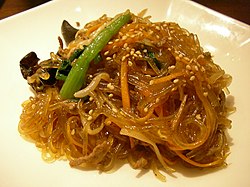
Back Korejské nudle Czech Fideos coreanos Spanish Kuksu Estonian Guksu (plat) French Kukszu Hungarian Guksu ID Spaghetti coreani Italian Guksu JV 한국의 국수 Korean Mi Korea Malay
 Japchae, a Korean dish of stir-fried cellophane noodles | |
| Type | Noodle |
|---|---|
| Place of origin | Korea |
| Korean noodles | |
| Hangul | 국수 / 면 |
|---|---|
| Hanja | |
| Revised Romanization | guksu / myeon |
| McCune–Reischauer | kuksu / myŏn |
 |
| This article is part of a series on |
| Korean cuisine 한국 요리 조선 료리 |
|---|
Korean noodles are noodles or noodle dishes in Korean cuisine, and are collectively referred to as guksu in native Korean or myeon in hanja character[clarification needed]. The earliest noodles in Asia originate from China, and date back 4,000 years ago.[1] In Korea, traditional noodle dishes are onmyeon (beef broth-based noodle soup), called guksu jangguk (noodles with a hot clear broth), naengmyeon (cold buckwheat noodles), bibim guksu (cold noodle dish mixed with vegetables), kalguksu (knife-cut noodles), kongguksu (noodles with a cold soybean broth) among others. In royal court, baekmyeon (literally "white noodles") consisting of buckwheat noodles and pheasant broth, was regarded as the top quality noodle dish. Naengmyeon, with a cold soup mixed with dongchimi (watery radish kimchi) and beef brisk broth, was eaten in court during summer.[2]
- ^ Lu, Houyuan; Yang, Xiaoyan; Ye, Maolin; Liu, Kam-Biu; Xia, Zhengkai; Ren, Xiaoyan; Cai, Linhai; Wu, Naiqin; Liu, Tung-Sheng. "Millet noodles in Late Neolithic China". Nature. 437 (7061): 967–968. doi:10.1038/437967a. ISSN 1476-4687.
- ^ Cite error: The named reference
Doosan Noodleswas invoked but never defined (see the help page).